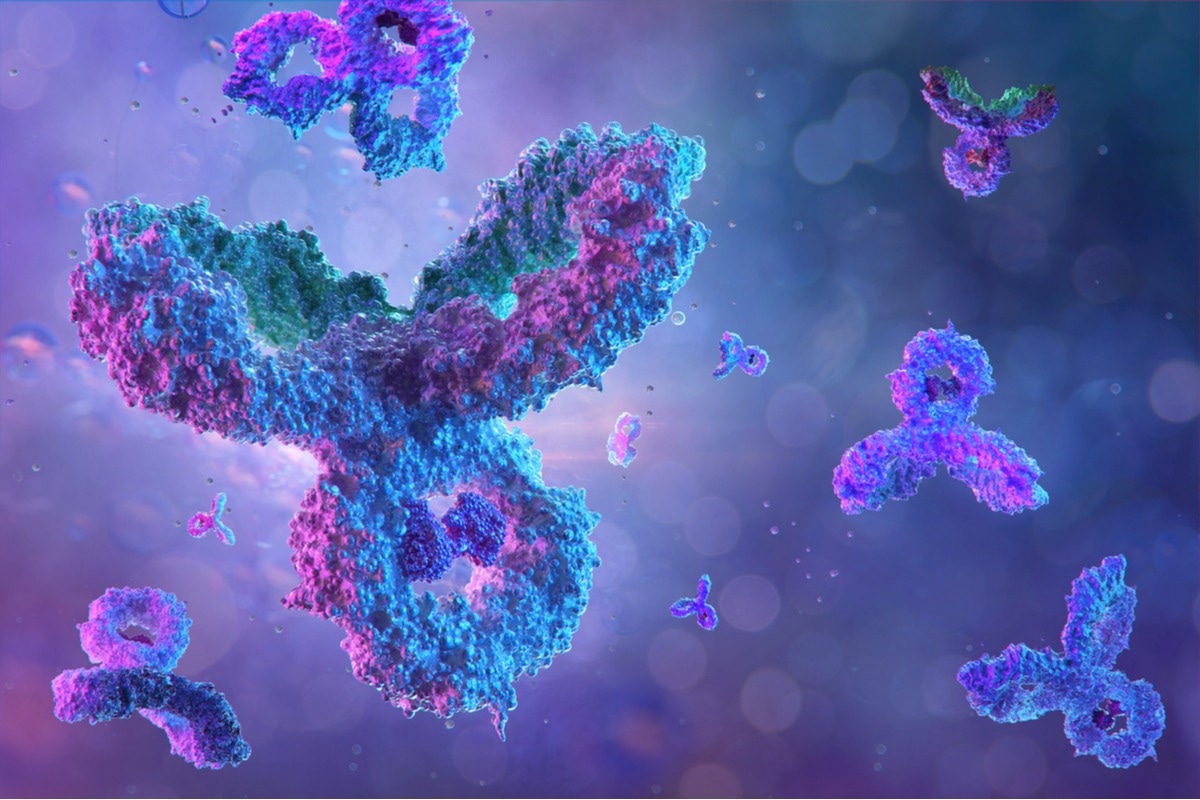An antibody (or immunoglobulin) is a glycoprotein produced by the immune system in response to a ‘foreign’ substance i.e. antigens present on microorganisms. Each antibody is unique and specific to a particular type of antigen - it will bind with its cognate antigen and neutralize the toxins produced by the microorganisms during infection. Antibodies are found in body fluids such as blood plasma, serum, saliva, and tears - in fact, they make up approximately 20% of the protein in plasma. Antibodies are frequently generated for use in research. They are classified into primary and secondary based on their binding capability and uses.

Image Credit: Corona Borealis Studio/Shutterstock
Structure of Antibodies
Primary and secondary antibodies share a common structure. Antibodies are Y-shaped molecules with 3 three portions of roughly equal size. They are composed of two identical light chains and two identical heavy chains – disulfide bonds join the two heavy chains together and each heavy chain to a light chain. The specific structure and combination of these chains allow the antibody molecules to bind to multiple cells at the same time. Separate parts of the antibody molecule can bind to a wide range of antigens and also to some effector molecules. The variable or V region of an antibody indicates/refers to the two arms of the Y structure and this region can bind to antigens. In contrast, the stem of the Y structure is called the constant or C region which can bind to only a limited number of effector cells and molecules.
Primary and Secondary Antibodies
Primary Antibodies
An antibody that can bind to a specific protein or a biomolecule of interest is called a primary antibody. Primary antibodies are produced as monoclonal (mAbs) or polyclonal antibodies (pAbs) using animal species such as the rat, mouse, goat, and rabbit as hosts. MAbs or pAbs have their own advantages and disadvantages which need to be considered before the selection of a primary antibody. MAbs are produced from a single B-cell clone of an animal and hence are directed against only one epitope of an antigen. PAbs are produced from multiple B-cell clones of an animal and have a heterogeneous mix of antibodies that are directed against several epitopes of an antigen. MAbs are ideal for identical production and standardization experiments and produce minimal or no background staining. There is also a reduced possibility of cross-reaction with undesired proteins while using a mAb.
Since pAbs can bind to multiple epitopes of a single antigen, they are capable of recognizing even minor variations in the antigen. They also yield a stronger antigen detection signal. Hence they are ideal for experiments involving denatured proteins. Primary antibodies are developed and supplied in different crude and purified forms. They find use in the detection of biomarkers for diabetes, cancer, Alzheimer’s, and Parkinson’s disease.
Secondary Antibodies
A secondary antibody binds with a primary antibody that is directly attached to the target antigen. After the V region of a primary antibody binds to the antigen, a labeled secondary antibody attaches its V region to the stem or C region of the primary antibody. Exploiting this interaction allows secondary antibodies to indirectly help in the detection and purification of target proteins (antigens). Secondary antibodies are more sensitive and flexible in labeling and detection – thus, they are used in the colorimetric, chemiluminescent, and fluorescent detection of primary antibodies in a series of applications including flow cytometry, western blotting, and cell imaging.
The selection of the type of secondary antibody is based on the class of the primary antibody – Immunoglobulins IgG or IgM, the preferred label type, and the source host. As most of the primary antibodies are developed using a few host species and most primary antibodies belong to the IgG class, manufacturers usually provide ready-to-use secondary antibodies that can be used in many different detection procedures and systems. Examples of commonly used secondary antibodies are anti-rabbit IgG, anti-mouse IgG, anti-chicken IgG or anti-goat IgG. The secondary antibody selected should always be capable of recognizing the host species in which the primary antibody was produced, e.g., in order to detect a primary antibody produced from a mouse, an anti-mouse secondary antibody is used. The optimal secondary antibody for a specific assay also depends on the label type. In ELISA and western blotting, the labeling is usually chemiluminescent, colorimetric, or fluorescence-based, but in flow cytometry and immunofluorescence, only fluorescent labels are used. A conjugated secondary antibody would be ideal for all these assays.
References
Further Reading